Related Research Articles
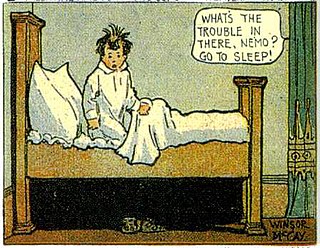
Little Nemo is a fictional character created by American cartoonist Winsor McCay. He originated in an early comic strip by McCay, Dream of the Rarebit Fiend, before receiving his own spin-off series, Little Nemo in Slumberland. The full-page weekly strip depicted Nemo having fantastic dreams that were interrupted by his awakening in the final panel. The strip is considered McCay's masterpiece for its experiments with the form of the comics page, its use of color and perspective, its timing and pacing, the size and shape of its panels, and its architectural and other details.
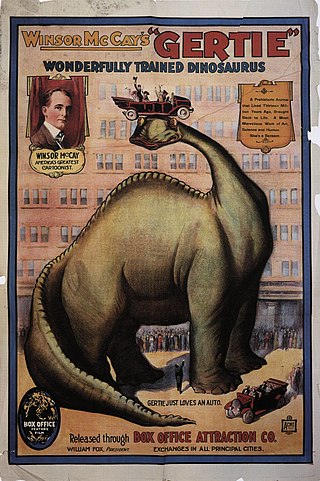
Gertie the Dinosaur is a 1914 animated short film by American cartoonist and animator Winsor McCay. It is the first animated film to feature a dinosaur. McCay initially presented the film before live audiences as an interactive part of his vaudeville act; the frisky, childlike Gertie performed tricks at her master's command. McCay's employer William Randolph Hearst curtailed his vaudeville activities, prompting McCay to add a live-action introductory sequence to the film for its theatrical release, which was renamed Winsor McCay, the Famous Cartoonist, and Gertie. McCay abandoned a sequel, Gertie on Tour, after producing about a minute of footage.

Zenas Winsor McCay was an American cartoonist and animator. He is best known for the comic strip Little Nemo and the animated film Gertie the Dinosaur (1914). For contractual reasons, he worked under the pen name Silas on the comic strip Dream of the Rarebit Fiend.

Dream of the Rarebit Fiend is a newspaper comic strip by American cartoonist Winsor McCay, begun September 10, 1904. It was McCay's second successful strip, after Little Sammy Sneeze secured him a position on the cartoon staff of the New York Herald. Rarebit Fiend appeared in the Evening Telegram, a newspaper published by the Herald. For contractual reasons, McCay signed the strip with the pen name "Silas".
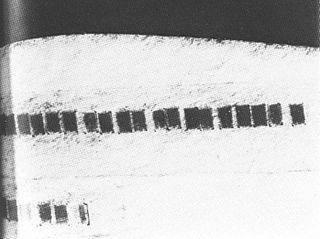
A microdot is text or an image substantially reduced in size to prevent detection by unintended recipients. Microdots are normally circular and around 1 millimetre (0.039 in) in diameter but can be made into different shapes and sizes and made from various materials such as polyester or metal. The name comes from microdots often having been about the size and shape of a typographical dot, such as a period or the tittle of a lowercase i or j. Microdots are, fundamentally, a steganographic approach to message protection.
The silent age of American animation dates back to at least 1906 when Vitagraph released Humorous Phases of Funny Faces. Although early animations were rudimentary, they rapidly became more sophisticated with such classics as Gertie the Dinosaur in 1914, Felix the Cat, Oswald the Lucky Rabbit, and Koko the Clown.
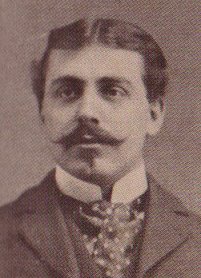
Vital Achille Raoul Barré was a Canadian cartoonist, animator of the silent film era, and painter. Initially known as a political cartoonist, he originated the French Canadian comic strip, then crossed over into animated film and started his own studio, a pioneering effort. As a painter, he is considered an Impressionist, evoking atmosphere and light with visible, choppy strokes of paint, whose paintings are in the Musée national des beaux-arts du Québec.

A microform is a scaled-down reproduction of a document, typically either photographic film or paper, made for the purposes of transmission, storage, reading, and printing. Microform images are commonly reduced to about 4% or 1⁄25 of the original document size. For special purposes, greater optical reductions may be used.

Pigeon post is the use of homing pigeons to carry messages. Pigeons are effective as messengers due to their natural homing abilities. The pigeons are transported to a destination in cages, where they are attached with messages, then the pigeon naturally flies back to its home where the recipient could read the message. They have been used in many places around the world. Pigeons have also been used to great effect in military situations, and are in this case referred to as war pigeons.

The Sinking of the Lusitania (1918) is an American silent animated short film by cartoonist Winsor McCay. It is a work of propaganda re-creating the never-photographed 1915 sinking of the British liner RMS Lusitania. At twelve minutes, it has been called the longest work of animation at the time of its release. The film is the earliest surviving animated documentary and serious, dramatic work of animation. The National Film Registry selected it for preservation in 2017.

John Randolph Bray was an American animator, cartoonist, and film producer.

How a Mosquito Operates is a 1912 silent animated short film by the American cartoonist Winsor McCay. The six-minute short depicts a giant mosquito tormenting a sleeping man. The film is one of the earliest works of animation, and its technical quality is considered far ahead of its time. It is also known under the titles The Story of a Mosquito and Winsor McCay and his Jersey Skeeters.
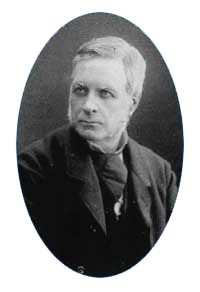
René Prudent Patrice Dagron was a French photographer and inventor. He was born in Aillières-Beauvoir, Sarthe, France. On 21 June 1859, Dagron was granted the first microfilm patent in history. Dagron is also considered the inventor of the miniature photographic jewels known as Stanhopes because a modified Stanhope lens is used to view the microscopic picture attached to the lens. He is buried at Ivry Cemetery, Ivry-sur-Seine.

A stanhope or stanho-scope is an optical device that enables the viewing of microphotographs without using a microscope. They were invented by René Dagron in 1857. Dagron bypassed the need for an expensive microscope to view the microscopic photographs by attaching the microphotograph at the end of a modified Stanhope lens. He called the devices bijoux photo-microscopiques or microscopic photo-jewelry.

A chalk talk is an illustrated performance in which the speaker draws pictures to emphasize lecture points and create a memorable and entertaining experience for listeners. Chalk talks differ from other types of illustrated talks in their use of real-time illustration rather than static images. They achieved great popularity during the late nineteenth and early twentieth centuries, appearing in vaudeville shows, Chautauqua assemblies, religious rallies, and smaller venues. Since their inception, chalk talks have been both a popular form of entertainment and a pedagogical tool.
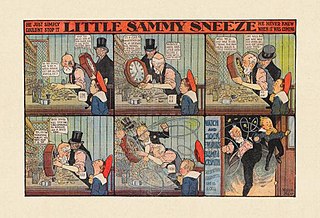
Little Sammy Sneeze was a comic strip by American cartoonist Winsor McCay. In each episode the titular Sammy sneezed himself into an awkward or disastrous predicament. The strip ran from July 24, 1904 until at least May 26, 1907 in the New York Herald, where McCay was on the staff. It was McCay's first successful comic strip; he followed it with Dream of the Rarebit Fiend later in 1904, and his best-known strip Little Nemo in Slumberland in 1905.
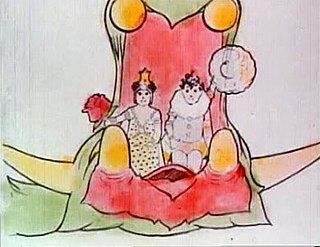
Winsor McCay: The Famous Cartoonist of the N.Y. Herald and His Moving Comics, more commonly known as Little Nemo, is a 1911 silent animated short film by American cartoonist Winsor McCay. One of the earliest animated films, it was McCay's first, and featured characters from McCay's comic strip Little Nemo in Slumberland. Its expressive character animation distinguished the film from the experiments of earlier animators.
Events in 1896 in animation.
Events in 1874 in animation.
References
- ↑ Herbert, Stephen. "Projection Phenakistoscope 1". www.stephenherbert.co.uk. Retrieved 19 July 2016.
- ↑ "Ross 'Wheel of Life' magic lantern slide". London: Science Museum Group. Retrieved 4 June 2017.
- ↑ Newsletter of the Illinois State Archives & The Illinois State Historical Records Advory Board Archived 16 May 2008 at the Wayback Machine Jesse White Secretary of State & State Archivist Volume 2 Number 1 Quote: "Despite Dancer’s early work, in 1859, Ree Dagron, a French optician, received the first patent for microfilm. Using Dancer’s techniques, Dagron manufactured and sold microphotograph trinkets. In 1870–71, during the Franco-Prussian War, Dagron demonstrated a practical use for microforms. During the siege of Paris, the French used carrier pigeons to transparrt microfilmed messages across German dices."
- ↑ The Pigeon Post into Paris 1870–1871 by J.D. Hayhurst O.B.E. Prepared in digital format by Mark HayhurstmCopyright ©1970 John Hayhurst Quote: "He now proposed to Rampont that his process should be applied to pigeon messages and a contract was concluded on 11th November. "
- ↑ The Focal Encyclopedia of Photography: Digital Imaging, Theory and Applications, History, and Science p. 94 By Michael R. Peres Contributor Michael R. Peres Published by Focal Press, 2007 ISBN 978-0-240-80740-9
- ↑ CHRONOLOGY OF MICROFILM DEVELOPMENTS 1800 – 1900 from UCLA
- ↑ Canemaker 2005, p. 22.
- ↑ Canemaker 2005, p. 160.
- ↑ Bendazzi 1994, p. 16.
- ↑ Canemaker 2005, p. 164.
- ↑ Crafton 1993, p. 110; Canemaker 2005, p. 183.
- ↑ Canemaker 2005, p. 195.
- ↑ Canemaker 2005, pp. 197–198.
- ↑ Canemaker 2005, p. 249.
- ↑ Syracuse Herald staff 1934.
- ↑ Europa Film Treasures: Les Kiriki, acrobates japonaises Archived 2012-10-22 at the Wayback Machine
- ↑ Gartenberg Media DVD "Segundo De Chomón (1903–1912): El Cine de la Fantasia"
- ↑ Paghat the Ratgirl, Wild Realm Review: Films of Segundo de Chomón
- ↑ "El escultor moderno - Vídeo Dailymotion". Dailymotion. 22 April 2008. Retrieved 2020-02-20.